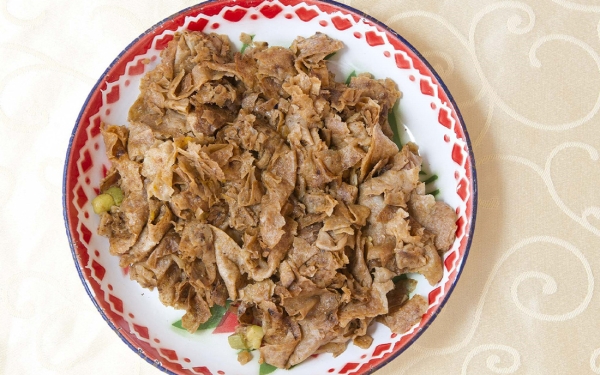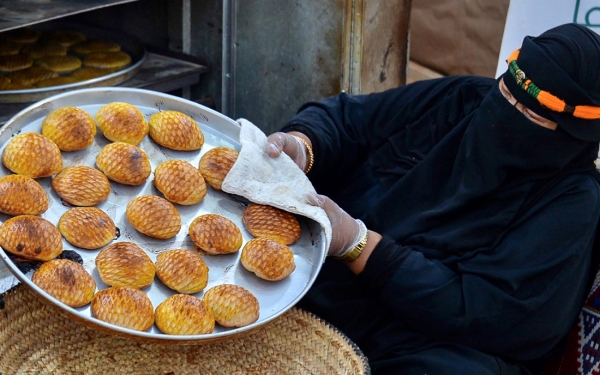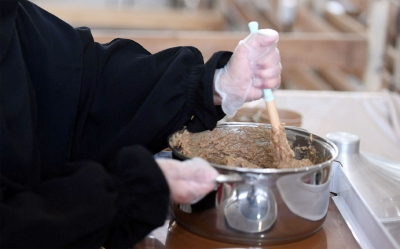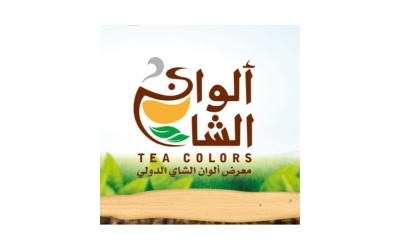


Traditional Food in Qassim Province is well-known food prepared by the locals of Qassim Province, with date products being the main ingredients, given the province's abundance of palm farms.
Al-Klija as a signature dish of Qassim Province
In 2024, the Culinary Arts Commission announced the designation of signature dishes for all provinces of the Kingdom of Saudi Arabia as part of the 'National and Regional Dishes Narratives' Initiative, naming "al-Klija" as the signature dish of Qassim Province.
Al-Klija to UNESCO
In 2021, Buraydah City was included in the UNESCO Creative Cities Network (UCCN) among 295 cities worldwide for its creativity in presenting al-Klija dish, which prominently features dates in its main ingredients.
Al-Klijais made by spreading dough and adding sugar, anise, ginger, and cardamom inside, then tucking and baking it in the oven for twenty minutes until being ready to serve.
In terms of entertainment, various festivals for traditional food are held annually in Qassim Province. Among these is al-Klija Festival, which celebrated its fifteenth edition in February 2024.
Hanaini
Hanaini is typically eaten early in the morning or for dinner. It is made from whole wheat flatbread (al-Qursan) mixed with date paste (usually from varieties like Maktoum or Sukkari dates), with added butter, lemon, and citrus pieces placed in the middle and on the sides. It is a popular traditional food, especially among the elderly during winter, as it provides high calories that warm the body.
Freekeh, Qurs al-Jamr, and Qurs Aqeel
Travel enthusiasts and desert campers prefer Freekeh, which is made from whole wheat with a little sugar, onions, and butter. It was a commonly consumed food in the past due to its nutritional value and ability to sustain travelers over long journeys without rest stops or restaurants. It contains proteins, minerals, and vitamins that provide the body with energy.
Qurs al-Jamr, or "Mullah Bread", is made from whole wheat and white flour, placed on hot coals, and covered with ash, gaining popularity among desert campers ‘Makasheet’ for its authentic taste. Qurs Aqeel, known in ancient Najd, was considered one of the best-sweetened foods for travelers. The name is derived from the Aqeelat men of Qassim Province who carried it on their trips to the Levant, Iraq, and Sudan. It was prepared in large quantities at home before the journey and stored in special containers. Aqeelat men used to eat it on camelback during their trading trips. Made from whole wheat flour, eggs, and sugar, baked in tannur in circular containers until being cooked and turned golden brown, Qurs Aqeel is one of the foods that lasts a long time without losing its flavor.
Aseeda
Aseeda, known in various periods in Qassim and the old Najd towns, is made from ground and crumbled corn that is placed in a pot and mixed with water, onions, and spices. The mixture is placed over low heat with a heat diffuser under the pot, stirred with a stick until soft, then left to cook before being served in bowls.
Matazeez
Matazeez is a well-known dish mastered by grandmothers and some mothers in Najd region, especially in Qassim Province. The word "Matazeez" is plural, with the singular being "Mitzaz" or "Matzooz." The name "Matazeez" is not mentioned in Arabic dictionaries; it is believed to be a blend of the Arabic words "matt," a verb meaning to stretch or extend (referring to the dough), and "zeez," meaning tiny, referring to small pieces of dough shrinking when cooked with meat and vegetables. Some think the word originates from "Mataqeeq," as the dough makes a crackling sound when baking, with the assumption that the letter 'Qaf' was replaced over time with the letter 'Zay'.The dish consists of two main components: 'dough' made from whole wheat flour and 'broth' made from lamb shoulder or leg, with added spices, tomato cubes, pumpkin slices, potato slices, eggplant slices, zucchini discs, and green bean stalks.
Al-Qursan
Al-Qursan has gained fame for its numerous benefits and is considered a favorite dish for visitors to the Kingdom. Its preparation requires a light iron griddle, continuously heated with wood from the Calligonum, Acacia, or Haloxylon trees, or a modern gas-operated griddle, which allows for easy temperature control. Al-Qursan is made from whole wheat dough placed on a hot griddle until it turns golden brown, then lifted with a knife or a special spatula, cut into small pieces, and placed in a dish or bowl. It is then mixed with cooked and well-boiled zucchini, eggplant, pumpkin, and beans, with added onions and tomato pieces. Butter and spices are added, and it is sprinkled with pepper and black lime, with the vegetable mix historically known as "Oqood".
Jareesh
In 2023, the Culinary Arts Commission designated Jareesh as the national dish of the Kingdom, Coinciding with the launch of the 'National and Regional Dishes Narratives' Initiative.
The name "Jareesh" comes from the coarse grinding of grains. It has achieved similar popularity to Matazeez and al-Qursan and is one of the easy and widespread dishes in the central region. Made from crushed wheat traditionally imported from Iraq and the Levant, it is cooked in a pot with added water and spices, then sour yogurt is added to give it a distinctive flavor and taste. Although it typically does not include meat, some add pieces of fat and aged tripe for a taste that surpasses that of meat. It is left on low heat until cooked, then stirred and mashed with a ladle to give it softness before being served on trays with added aloe, onions, butter, and pure ghee. It is served hot on various occasions and wedding celebrations.
Ad-Duwayfah
Historically, some families relied on ad-Duwayfah as one of the consumed foods in Buraydah City, some governorates of Qassim Province and Najd towns due to its quick preparation, simple ingredients, and ease of digestion. Made from ground whole wheat, water, salt, and onions, it is cooked in a pot on low heat and stirred with a ladle until done, then transferred to another serving container for the family to eat. It is particularly beneficial for the elderly and young children. Nowadays, ad-Duwayfah has been replaced by oatmeal or barley soup and is rarely prepared except in traditional villages or spring festivals.
Al-Mohalla
Dates play a primary role in the composition of al-Mohalla, where they are soaked in water for about six to eight hours, and then strained through a sieve. The strained dates are then placed in a pot to be cooked on medium heat and mixed with whole wheat flour sprinkled on the mixture and added to the dates, with continuous stirring for two to three hours. Butter or pure ghee is added while stirring until the dates and flour blend smoothly. It is preferred to be served hot.
Al-Marassi'
Al-Marasee', or Maraheef, Maraqeesh, or Masabeeb, is known by various names and prepared with different additions across the Kingdom. It is a dish commonly made in the central provinces. The name, size, and spices vary by province, but it typically consists of small bread discs made by pouring a liquid mixture onto a griddle. It is served as a light meal, either savory or sweet depending on the chosen additions, and is often eaten during winter and Ramadan.
Al-Marassi’ is made from whole wheat flour, cut into small circles, and left on a hot griddle on both sides until cooked. The discs are then collected in a container and topped with butter, sautéed onions, black lime, sugar, and milk. For the modern Maraqeesh, formerly known as Masabeeb, three cups of water, three eggs, two small cups of powdered milk, and a tablespoon of yeast are blended with a quarter kg of whole wheat flour in an electric mixer. The mixture is then cooked on an electric griddle or a traditional hot griddle.
Related quizzes
Related articles

